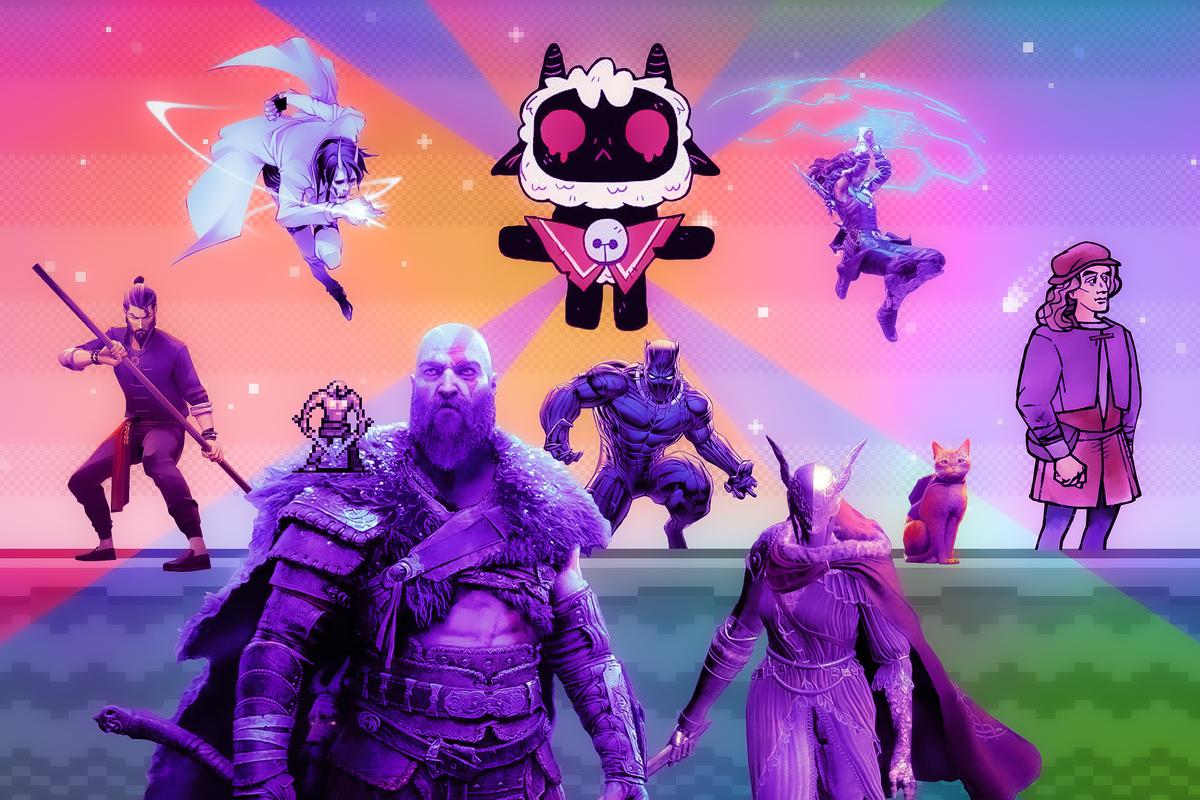The Best Video Games of 2022
From ambitious, satisfying sequels to engrossing, refreshing originals, these are the interactive titles that rose to the top
Like most entertainment ecosystems, the gaming industry exists in a state of flux and upheaval. In 2022, massive companies acquired each other (or tried to). Some studios unionized to combat crunch and toxic cultures. Investors and publishers coped with decreases in revenue following two years of pandemic-induced upticks in screen time, even as supply-chain snafus continued to keep consoles out of stores and living rooms, and COVID-caused development delays wreaked havoc with release schedules. Big game after big game got bumped to later dates, but it didn’t matter—there was no shortage of innovative, varied, and well-crafted titles to play, as indie developers rode to the rescue of gamers burned by blockbuster no-shows.
This year, the Switch soared despite aging hardware and release lulls in some of Nintendo’s flagship franchises; Valve’s Steam Deck opened a new frontier in handheld gaming; and the depth of Microsoft’s Game Pass library compensated for a lack of Xbox exclusives. Highlight releases ranged from long-anticipated sequels to original, out-of-nowhere sensations; from free-to-play mobile games to Triple-A, audiovisual spectacles; and from incremental improvements on proven formulas to audacious evolutionary leaps. As always, there were too many good games for any one person (or three people) to play—some games, it turns out, are really long—but we did our best to distill our richest unscripted experiences into a compact top 10. These are The Ringer’s best video games of 2022—plus some honorable mentions, because we couldn’t help ourselves.
10. Pentiment
If you’re not primarily playing games for the story or characters, and you require that buttons be mashed, then you can skip Pentiment. It’s OK; this game is not for everyone. But this game is for more people than you might imagine, considering it consists of a whooooole lot of reading and walking around. Try to imagine the best-case scenario for a game with non-stop text and no inventory or combat system. Now imagine that kind of game dropped into the historical setting of the 16th-century Holy Roman Empire. Also, the game takes a while to really get going.
Are you still reading this? For everyone who hasn’t already left to boot up Call of Duty, Pentiment is a bold and beautifully executed vision of a video game. It’s one of the most tonally and visually distinctive games released this year, and its writing and clever design tell a story I’ll never forget.
Pentiment follows Andreas Maler, an artist who arrives at a small Bavarian town to assist a monastery in producing its illuminated manuscripts. The monastery’s scriptorium is already an anachronism, because the recent invention of the printing press has started to allow almost anyone to mass-disseminate information, loosening the church’s grip on the written word and reducing the demand for meticulously hand-drawn manuscripts. Don’t worry, Pentiment has a built-in glossary that concisely explains every term, place, or concept (such as “scriptorium”) that you might be unfamiliar with if, like me, you happen to be a product of the American education system.
On the surface, Pentiment is a murder mystery that unfolds over three acts, with a time jump between each act. Your conversations and difficult decisions have ramifications that unfold across generations. On a deeper level, Pentiment is about the intersection of faith and morality, and the resilient power of knowledge. —Matt James
9. Cult of the Lamb
You spend a lot of time picking poop up off the ground in Cult of the Lamb, and it’s still one of the most enjoyable games of the year. The poop belongs to the shameless followers of your cult, who have absolutely no problem taking big ol’ dumps in the middle of the town square if there are no outhouses for them to use. Of course, you can run your cute little cult however you see fit. You build the outhouses whenever you get around to it, just as you release dissenters from their public humiliation or bury the dead bodies of loyal followers whenever you get around to it. When you’re not busy running your little cult town and performing sadistic rituals to keep your followers in check, you venture off into the world to fight through procedurally-generated dungeons, collecting all the wealth and resources needed to manage all the pooping, sleeping, and eating that goes on back in town.
Cult of the Lamb is two games in one: It’s half farming/town simulator and half roguelike. It does both of these things quite well, but the inherent drawback in designing a game to be two different things is that the player will likely prefer one over the other. I expected to be more invested in the dungeon-crawling half of the game, but I ultimately found town-building to be more rewarding. Many people prefer the dungeon-crawling. Whichever way you lean, the game has enough character and dark humor to keep you engaged throughout.
For me, the real joy of Cult of the Lamb lies in the freedom to decide how kind or evil you want to be to your adorable minions. You don’t have to feed anyone poop. The choice is yours. There is a lot of poop lying around, though. —James
8. Stray
Yes, Stray is the cat game. As a dog guy, though, I can vouch for there being much more to this debut by BlueTwelve Studio than a finely rendered feline. Although the well-animated kitty made Stray internet famous, its secret weapon was its world, which was engrossing even after the charm of its protagonist’s nuzzling, kneading, and purring wore off. (Fine, no, it never really wore off. The cat is cute, OK?) Suffused with warmth yet made melancholy by loss, Stray’s posthuman, domed-city setting was the perfect conduit for detailed environmental storytelling. Although the puzzles and sporadic kinda-combat sequences weren’t GotY material, the exploration and level design; understated, well-paced, and poignant narrative; and often-catchy but sometimes-unsettling score combined to produce a compact and powerful game. Short enough to be finished in a few sittings, yet ambitious and polished enough to pass for a Triple-A release, the Annapurna-published adventure was the perfect palate cleanser after the open-world epics that dominated the first half of the year. Speaking of which … —Ben Lindbergh
7. Horizon Forbidden West
Horizon, as a series, is in a strange place. It’s a big-budget, plot-driven console exclusive, but it’s always getting upstaged—critically and commercially—by even bigger, generation-defining titles: first Breath of the Wild, which arrived a week after Horizon Zero Dawn in 2017, and then Elden Ring, which was released a week after Horizon Forbidden West this past February. Unfortunately, Forbidden West spent the spring and summer of Elden Ring as a punching bag that absorbed everyone’s pent-up frustrations with the state of open-world game design. But the truth is that Forbidden West is a great game. It’s got a lot more heart and humor than Zero Dawn, and while the first game stoked barely enough intrigue to justify its sequel-baiting cliffhanger ending, Forbidden West maxed out its big-brained, sci-fi soap-opera shenanigans to a delightful extreme. Nonetheless, the real draw remains dismantling giant robotic dinosaurs with impractical hi-tech archery. I’ll never get tired of looting those plates, bursting those canisters, and sending yet another Slaughterspine crashing into the dirt. —Justin Charity
6. Sifu
From college age to the grave, you fight till you die. Sifu is a rather clever game, with its nifty aging mechanic and its marathon hit list structure, which requires you to cut through mobs with wisdom and finesse. This game snaps; that’s the simplest way I can express its tactile brilliance. It’s not quite God Hand—it’s a bit too stoic and straightforward to support that common comparison—but Sifu makes beating the shit out of henchmen extremely gratifying on a downright primal level. The grunts swarm you, and though they tend to abide by the timeless clichés of martial arts choreography—loitering at the perimeter of an ambush, taking a number, and waiting to get their asses beaten in a one on one with the hero—you’ve got a lot more to lose than they do, and you can make only so many mistakes in your playthrough before losing your momentum altogether. So you’re not just plotting but also optimizing your revenge against the traitors who murdered your master, a mission that must be completed before you reach the ripe old age of 75. Your first winning playthrough is a real rush—one of the year’s best experiences in gaming. —Charity
5. Marvel Snap
I was not in the target market for Marvel Snap. I’m neither a mobile game guy nor a card game guy, which would seem to put me squarely in a no-Snap zone. But thanks to its fast-moving six-round matches, its accessibility compared with that of some CCGs, and its relative restraint in enticing me to spend—by the standards of most gacha games funded by potentially predatory micro-transactions, at least—Snap overcame my qualms and made me fall for it fast. Snap is simple but not simplistic, finding the balance between the strategy of snapping and deploying cards and the randomness of draws and devious locations. The Marvel branding is, at best, a bonus: The characters on the cards are a treat for fans of the comics, but one could swap out the supes for some other heroes and the game would retain its powerful pull. In retrospect, a team up between the brains behind Hearthstone and the world’s most unstoppable IP seems like a clear recipe for a sensation. But before we had that hindsight, Snap’s smash success made it one of gaming’s most pleasant surprises. —Lindbergh
4. Vampire Survivors
One of the best action games of the year doesn’t even have an attack button. In Vampire Survivors, your character fends off endless waves of spooky enemies using weapons that fire at specific intervals. Your only responsibility at the controls is maneuvering your character through the levels while the weapons do their thing. Collecting gems from fallen enemies will level you up, providing you with a choice of upgrades. Will you choose to power up your fire wand, reduce weapon cooldown, or enable an aura of damage around yourself? The only thing you retain after each inevitable death is the gold you’ve collected, so experimenting with the many different combinations of weapons and abilities is encouraged and rewarded.
Vampire Survivors kind of looks like shit, in an endearing and nostalgia-inducing way; it would fit in well with a bunch of floppy disk PC games from the ’90s. And if you’re old enough to remember the classic PC game SkiFree, you’ll already be quite familiar with monsters that appear at the time limit of a level to remind you of the inescapability of death. Retro tributes aside, Vampire Survivors is packed with surprises, unlocks, characters, and excitement. Its game play loop is at once extraordinarily simple and delightfully nuanced. All in all, Vampire Survivors feels like a video game that’s been expertly distilled down to its most essential elements. Play it. —James
3. Neon White
Is it a platformer? A puzzler? A shooter? A dating sim? A deck-building card game? Yes, and I may have missed a genre or two. Neon White defies categorization but not celebration. It’s stylish, lightning quick, and fiendishly challenging, though it rarely feels unfair. I’m not wired in a way that ever made me pump quarters into arcade cabinets in search of new high scores, but Neon White is so smooth and empowering that it makes me want to be better at, well, whatever it is. I don’t need card mechanics to invade every game—I’m already coping with way too much crafting I don’t want to do—but designer Ben Esposito’s spin on the trope is intoxicatingly clever. The anime-influenced art style, the adrenaline rushes at the end of quick-twitch traversals, the endless replayability—Neon White is nothing like the next two titles on our list, but its moment-to-moment fun quotient compares favorably to that of any other game released this year. Neon White turns all of us into the speed runner at home, letting us appreciate perfect runs even if we aren’t quite capable of authoring them. If you want to feel a flow state, surrender to its siren song. —Lindbergh
2. God of War Ragnarök
The biggest blockbuster release in single-player gaming this year was God of War Ragnarök. Despite ludicrously high expectations for the sequel to the beloved God of War reboot from 2018, Ragnarök was pretty much everything players had hoped for and an absolute thrill of a video game.
Aside from Ben’s very fair criticism of how often narrow passages must slowly be shimmied through, I have no significant knocks against this game. Ragnarök’s combat system evolved just enough to be fresh while still feeling familiar. The graphics and sound are absolutely stunning. The voice acting and storytelling can go toe to toe with some of the best games of all time.
Ultimately, Ragnarök came just short of being our game of the year because it’s a continuation of a great game that came out four years ago. It’s much more a “Part 2” than a sequel. To be fair, though, that’s exactly what I wanted out of this game, and Santa Monica Studio delivered on every level. We felt that the game of the year should be a title that innovates and leaves a large cultural footprint while changing the way developers think about the games they make. This year, that game was Elden Ring. —James
1. Elden Ring
Behold, dog! The game of the year! Given my total playtime—127 hours, Steam tells me—I’m embarrassed to say I still can’t quite explain the basic plot (much less the miscellanea and esoterica) of Elden Ring. The ring isn’t literally a ring? Radagon and Marika are the same person? The turtle is a dog? The dog is a pope? They buffed Malenia? What? Why? Elden Ring answers to no one. It’s an untold volume of imagination, spilled—with you along with it—into a dark and bottomless pit. It delivers a totally engrossing mythology and an awesomely open-ended experience, punishing your cowardice, rewarding your curiosity, and commanding you to be a better player. (Yes, even when you’re spamming the Fire Giant with Comet Azur from 10 miles away.) You wander the Lands Between with minimal guidance, and your choices—each converging toward or diverging from your inevitable commitment of the cardinal sin—feel much more momentous than the slight differences among the brief cutscenes that can play at your journey’s end. Oh, who am I kidding? This journey never ends. I won’t tell you how many playthroughs got me to 127 hours (and counting). —Charity
Honorable mentions: Bayonetta 3, Escape Academy, Immortality, Lego Star Wars: The Skywalker Saga, Mario + Rabbids Sparks of Hope, MultiVersus, Norco, PowerWash Simulator, Return to Monkey Island, Rogue Legacy 2, Splatoon 3, Teenage Mutant Ninja Turtles: Shredder’s Revenge, Tunic


